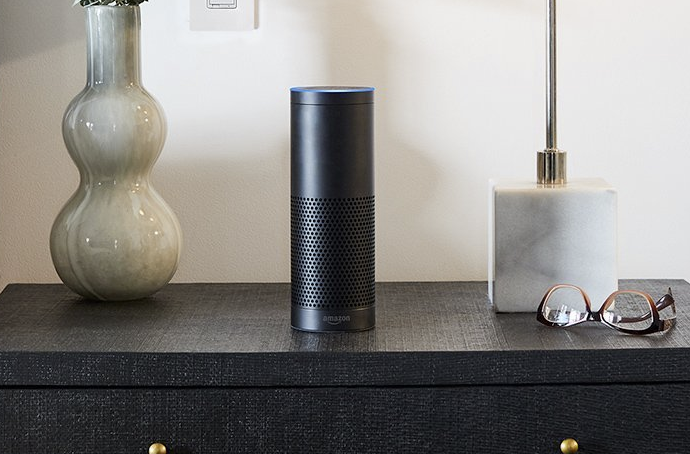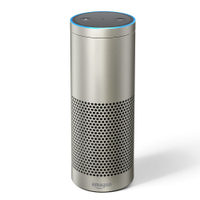Why Amazon Echo Plus Is a ‘Game-Changer’ for Smart Homes
By integrating a smart home hub into its Echo Plus, Amazon is making it a lot easier to control -- and sell -- other devices controlled by Alexa.
Although it may look like the original Echo, the inclusion of a Zigbee smart-home hub inside the Amazon Echo Plus means that it just got a lot easier for consumers to build out their own smart homes. It also means the Echo Plus will make it a lot harder for other smart-home-hub makers, too.

Zigbee is an open-communications protocol built into a ton of smart-home devices, such as Philips Hue lights and smart locks. Because of its low-power requirements, it’s ideal for small devices, or those whose design would make it inconvenient for a large battery, or to be plugged in. A great example of this are door and window sensors.
However, Zigbee devices can’t connect directly to the Internet, which is what enables you to control them remotely. They first must link to a bridge or hub (such as the Samsung SmartThings or Wink Hub 2), which itself is connected to your home network. It’s an inconvenient, but necessary, step.
Now that a Zigbee radio is built into the Echo Plus, you no longer need to purchase an extra device to pair with your lights. You can simply pair it with the Echo Plus. You’ll still need Philips’ own bridge if you want to have your lights change colors and use more advanced features such as geofencing, but if all you want is to turn the lights on and off and dim them, then it’s not necessary.
MORE: Our Favorite Smart Home Guide
“Now that Amazon has that hub built in, it’s going to put more pressure on SmartThings and Wink,” said Blake Kozak, a principal analyst at IHS Markit. “What’s interesting about the [Echo] Plus is that it supposedly doesn’t require any apps. That’s been a big challenge with smart home and voice assistants, because you still may need 10 apps to set up those individual devices before you can control it through Alexa.
“Now that Amazon has that hub built in, it’s going to put more pressure on SmartThings and Wink.” — Blake Kozak, principal analyst, IHS Markit
“Despite all the talk of removing all the apps, no one’s really done it,” Kozak says, which is why he thinks it will be “a huge game changer.”
“The Philips Hue bridge isn’t going anywhere,” said George Yianni, head of Technology -- Home Systems for Philips Lighting. “It enables us to keep adding to this experience. Consumers can enjoy the 700 third-party apps, Hue sensors and switches, custom scenes, new entertainment capabilities and much more with the Philips Hue bridge.”
There is another major smart-home standard, Z-Wave (which requires companies who use it to pay a licensing fee), which is not in the Echo Plus, but is included in the Samsung SmartThings hub. However, Amazon’s adoption of Zigbee could also spell trouble for the continued success of Z-Wave.
MORE: Zigbee, Z-Wave, Thread and WeMo: What’s the Difference?
Another feature announced by Amazon that could also mean trouble for other smart-home hubs is the ability to create “routines,” a set of actions triggered by a single command. This is also one of the bigger selling points of smart-home hubs. For instance, you could say (or press the button) for Good Morning, and have the thermostat change temperature, the lights come on, the blinds raise and your wake-up music start playing. Now, you’ll be able to do that right through Alexa.
Putting a smart-home hub inside the Echo is “a very shrewd move to capitalize on the fact that they’re one of the world’s largest e-tailers,” said Paul Erickson, an analyst from IHS. “They benefit from the fact that Amazon sells a lot of smart home merchandise. It’s a built-in revenue chain, as they can bundle it with a great deal of other things.”
You could say ‘Good Morning,’ and have the thermostat change temperature, the lights come on, the blinds raise and your wake-up music start playing.
While Google may seem behind now, Erickson believes it will eventually pull ahead, simply because its Android operating system — and Google Assistant — is far more pervasive. “You’re seeing a landscape where there’s speakers, Android Auto, TVs with Chromecast - the entire ecosystem as a landscape goes to Google.”
So it’s up to Bezos and company to keep one step ahead of the competition, and the range of Alexa-enabled devices announced this week, as well as its integration in third-party devices, reflects that reality.
“For Amazon, they’re keenly aware that while the Google Assistant train is getting up to speed, this is a crucial time for them to seed the market with Alexa devices,” Erickson says. “They’re helping push the envelope. They’re experimenting in other ways other manufacturers are not, and continually moving the goalposts.”
Sign up to get the BEST of Tom's Guide direct to your inbox.
Get instant access to breaking news, the hottest reviews, great deals and helpful tips.

Michael A. Prospero is the U.S. Editor-in-Chief for Tom’s Guide. He oversees all evergreen content and oversees the Homes, Smart Home, and Fitness/Wearables categories for the site. In his spare time, he also tests out the latest drones, electric scooters, and smart home gadgets, such as video doorbells. Before his tenure at Tom's Guide, he was the Reviews Editor for Laptop Magazine, a reporter at Fast Company, the Times of Trenton, and, many eons back, an intern at George magazine. He received his undergraduate degree from Boston College, where he worked on the campus newspaper The Heights, and then attended the Columbia University school of Journalism. When he’s not testing out the latest running watch, electric scooter, or skiing or training for a marathon, he’s probably using the latest sous vide machine, smoker, or pizza oven, to the delight — or chagrin — of his family.

